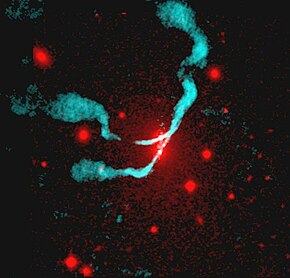NGC 1128 is a dumbbell galaxy in the Abell 400 galaxy cluster. At the center of the galaxy is 3C 75, a radio source, and contains two orbiting supermassive black holes that may be merging. Computer simulations indicate that these two black holes will gradually spiral in toward each other until they merge. Lewis Swift is credited with the discovery of NGC 1128 in 1886. [3]
| NGC 1128 | |
|---|---|
 Binary black hole system 3C 75 contained in the dumbbell shaped galaxy NGC 1128 | |
| Observation data (J2000 epoch) | |
| Constellation | Cetus |
| Right ascension | 02h 57m 41.6s[1] |
| Declination | +06° 01′ 29″[1] |
| Redshift | 6940 ± 20 km/s[1] |
| Distance | 300 Mly[2] |
| Apparent magnitude (V) | 13.8[1] |
| Characteristics | |
| Type | E0[1] |
| Apparent size (V) | 0'.9 × 0'.4[1] |
| Notable features | Dumbbell-shaped galaxy |
| Other designations | |
| PGC 11188, 11189[1] | |

References
edit- ^ a b c d e f g "Results for object NGC 1128". NASA/IPAC Extragalactic Database. Retrieved 26 October 2006.
- ^ "APOD: 2017 October 22 – Two Black Holes Dancing in 3C 75".
- ^ Seligman, Courtney. "Celestial Atlas: NGC Objects: NGC 1100–1149". cseligman.com. Archived from the original on 25 July 2015. Retrieved 25 July 2015.
External links
edit- Media related to NGC 1128 at Wikimedia Commons
- Black Holes Dance With Incredible Violence (SpaceDaily) 12 April 2006
- 3C 75 in Abell 400: Black Holes Determined to be Bound (Chandra AXAF)
- More Images of 3C 75 in Abell 400 (Chandra AXAF)
- NGC 1128 (jpeg, Chandra AXAF)
- NGC 1128 on WikiSky: DSS2, SDSS, GALEX, IRAS, Hydrogen α, X-Ray, Astrophoto, Sky Map, Articles and images